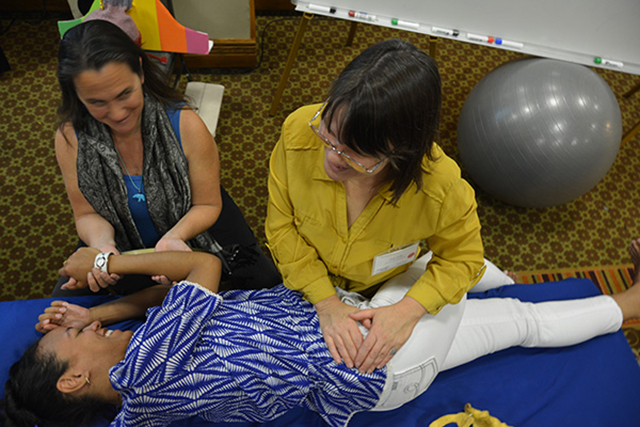
Reference the instructions on Side-lying Release on the website or handout you received after the workshop. The following will not make sense until you know the first set of instructions.

Have the shoulders aligned before concerning yourself about hips and legs. A piece of furniture is the best thing for the receiver to hold with their upper arm (or hospital bed railing).
Bring the lower hip so close to the edge of a bed, hospital bed, or edge of the couch that the fully pregnant belly extends over the edge. Hold the top hip firmly without digging thumb or fingers into the soft muscles of the groin or waist.
Then have the leg come up (just to the level of the top hip) and over the lower thigh to hang loosely down from the bed. The leg on the bed remains as straight as that person can comfortably hold.
The head and neck are straight, not tipped. Turning to look up is not helpful.
Hold the position on one side for 3 contractions, during and between. Your body posture will determine whether you hurt your back or not. Relax your shoulders, let your pelvis do your work. Stand so you are balanced but also give the person you are helping a clear assurance you won’t let them fall. Hold them where softness is firm, and where firmness is soft, so they can truly relax. This connection takes attention and effort to do well.
Gently switch sides for 3 more contractions on the other side. Be forewarned, there may be only 2 contractions on the second side before a pause (approximately one-hour) in contractions – or, there may be a sudden shift to full dilation with an urge to stand and push.

Our friend, Adrienne Caldwell adds this:
“If after the Side-lying Release there is a pause longer than 5 minutes, tuck them in for a nap on their left side (if best for them) and keep an ear on sounds. The spontaneous, reflective urge to push may result if baby had been engaged. On the other hand, if baby wasn’t engaged and now you have regular contractions – help the birthing person use them with Move Smart positions to open the brim during the contractions.
Review the Spinning Babies Quick Reference download or booklet to match the moves to the level of the pelvis. If baby is engaged and contractions space out, that’s a good sign. In an hour you may hear the change in vocalizations as labor progresses.
If the uterus is happy to continue working, you won’t have a pause, but perhaps a baby or progress to the next pelvic level. Then reassess baby to level diameters and position accordingly…”
Please check out Adrienne Caldwell’s powerful blog for more Side-lying Release details.
“…[S]idelying release has become part of normal prenatal care with my clients.” – Lynn in Pennsylvania
“The midwives have decided to do Side-lying Release before any cesarean [non-emergency, I would assume]. Since our protocols must be evidence-based, we will be studying Side-lying Release.” – Chief of Staff, Stavanger, Norway
Further Reading:
Upcoming Workshops
[tribe_events_list limit=”4″]
One of our most beloved products, now with subtitles in English, French, and Spanish, offering expert support to reduce intervention and increase comfort throughout pregnancy and birth.